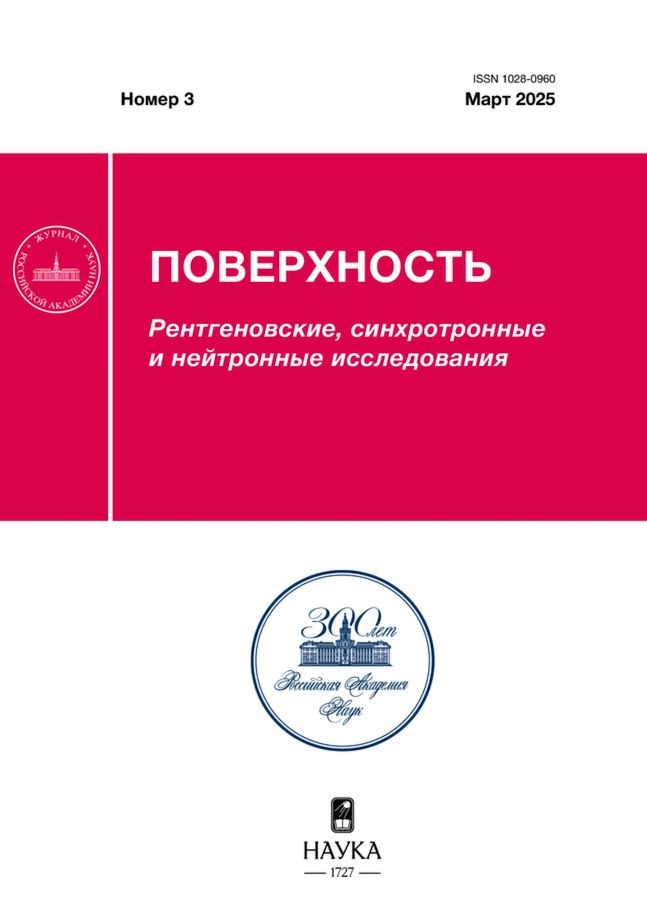Энергетические спектры атомов, распыленных ионами низких энергий: компьютерное моделирование
- Авторы: Шульга В.И.1
-
Учреждения:
- Институт ядерной физики им. Д. В. Скобельцына Московского государственного университета имени М. В. Ломоносова
- Выпуск: № 3 (2025)
- Страницы: 69-74
- Раздел: Статьи
- URL: https://j-morphology.com/1028-0960/article/view/687681
- DOI: https://doi.org/10.31857/S1028096025030111
- EDN: https://elibrary.ru/EMFPTF
- ID: 687681
Цитировать
Полный текст
Аннотация
Проведен расчет энергетических спектров и средних энергий распыленных частиц для ряда аморфных мишеней (Si, Ti, Ni, V, Nb), бомбардируемых ионами Ar с энергий 1 кэВ. В расчетах использованы программы компьютерного моделирования OKSANA и SRIM-2013. Показано, что для мишеней, атомы которых тяжелее падающих ионов, при расчетах с помощью программы SRIM оказывается переоценен вклад в распыление быстрых атомов отдачи и сильно завышена средняя энергия распыленных частиц. Это особенно заметно в результатах вычислений с использованием поверхностной энергии связи, найденной путем достижения согласия между расчетными коэффициентами распыления и экспериментальными. Проведено сравнение результатов моделирования с аналитическими оценками средней энергии распыленных атомов, выполненными на основе линейной теории распыления. Показано, что во всех рассмотренных случаях эти оценки также сильно завышены, поскольку в них не учтена деградация каскадов соударений при низких энергиях бомбардировки. Отмечено хорошее согласие результатов моделирования с использованием программ OKSANA, TRIM.SP и ACAT.
Полный текст
Об авторах
В. И. Шульга
Институт ядерной физики им. Д. В. Скобельцына Московского государственного университета имени М. В. Ломоносова
Автор, ответственный за переписку.
Email: vish008@yandex.ru
Россия, Москва
Список литературы
- Распыление под действием бомбардировки частицами. III. Характеристики распыленных частиц, применения в технике. / Ред. Бериш Р., Виттмак. К. М.: Мир. 1998. 551 с.
- Sputtering by Particle Bombardment. Experiments and Computer Calculations from Threshold to MeV Energies. / Ed. Behrisch R., Eckstein W. Springer, Berlin, 2007. 459 р.
- Ziegler J.F., Ziegler M.D., Biersack J.P. // Nucl. Instrum. Methods Phys. Res. B. 2010. V. 268. P. 1818. https://www.doi.org/10.1016/j.nimb.2010.02.091.
- Hofsäss H., Zhang K., Mutzke A. // Appl. Surf. Sci. 2014. V. 310. P. 134. https://www.doi.org/10.1016/j.apsusc.2014.03.152
- Shulga V.I. // Appl. Surf. Sci. 2018. V. 439. P. 456. https://www.doi.org/10.1016/j.apsusc.2018.01.039
- Mahne N., Čekada M., Panjan M. // Coatings. 2022. V. 12. P. 1541. https://www.doi.org/10.3390/coatings12101541
- Mahne N., Čekada M., Panjan M. // Coatings. 2023. V. 13. P. 1448. https://www.doi.org/10.3390/coatings13081448
- Экштайн В. Компьютерное моделирование взаимодействия частиц с поверхностью твердого тела. М.: Мир. 1995. 319 с.
- Shulga V.I., Eckstein W. // Nucl. Instrum. Methods Phys. Res. B. 1998. V. 145. P. 492. https://www.doi.org/10.1016/S0168-583X(98)00626-0
- Ziegler J.F., Biersack J.P., Littmark U. The Stopping and Range of Ions in Solids, Vol. I. Pergamon, New York, 1985.
- Oen O.S., Robinson M.T. // Nucl. Instrum. Methods. 1976. V. 132. P. 647. https://www.doi.org/10.1016/0029-554X(76)90806-5
- Lindhard J., Scharff M. // Phys. Rev. 1961. V. 124. P. 128. https://www.doi.org/10.1103/PhysRev.194.128
- Шульга В.И. // ЖТФ. 2023. Т. 93. С. 1401. https://www.doi.org/10.21883/JTF.2023.10.56276.147-23
- Sigmund P. Sputtering by ion bombardment: theoretical concepts. // Sputtering by Particle Bombardment I. Physical Sputtering of Single-Element Solids. / Ed. Behrisch R. Springer, Berlin. 1981. P. 9.
- Thompson M.W. // Philos. Mag. 1968. V. 18. P. 377. https://www.doi.org/10.1080/14786436808227358
- Held J., Hecimovic A., von Keudell A., Schulz-von der Gathen V. // Plasma Sources Sci. Technol. 2018. V. 27. P. 105012. https://www.doi.org/10.1088/1361-6595/aae236
- Eckstein W. // Nucl. Instrum. Methods Phys. Res. B. 1986. V. 18. P. 344. https://www.doi.org/10.1016/S0168-583X(86)80056-8
- Dembowski J., Oechsner H., Yamamura Y., Urbassek M. // Nucl. Instrum. Methods Phys. Res. B. 1986. V. 18. P. 464. https://www.doi.org/10.1016/S0168-583X(86)80072-6
- Lindsey S., Hobler G. // Nucl. Instrum. Methods Phys. Res. B. 2013. V. 303. P. 142. https://www.doi.org/10.1016/j.nimb.2012.12.087
- Brizzolara R.A., Cooper C.B., Olson T.K. // Nucl. Instrum. Methods Phys. Res. B. 1988. V. 35. P. 36. https://www.doi.org/10.1016/0168-583X(88)90095-x
- Mousel T., Eckstein W., Gnaser H. // Nucl. Instrum. Methods Phys. Res. B. 1999. V. 152. P. 36. https://www.doi.org/10.1016/s0168-583X(98)00976-8
- Shulga V.I. // Vacuum. 2024. V. 230. P. 113644. https//www.doi.org/10.1016/j.vacuum.2024.113644
Дополнительные файлы















